We now live in the digital era, meaning everything we do to improve the bottom line involves digital technologies. Increasingly, businesses must adopt digital technologies or risk becoming irrelevant.
Digital adoption strategies are the set of actions and processes that a company takes to ensure that its employees are using digital technologies effectively and efficiently.
These strategies are important because they help businesses ensure that they are getting the most out of their digital investments and that their employees can work effectively in a digital environment.
However, most strategies fail because the staff does not adopt technology appropriately. The issue is that many organizations do not use the right tools to drive digital adoption.
The reason is that the digital adoption strategy represents a complex process with little to do with technology. Digital adoption is primarily about people and ensuring they know what they will get from the strategy, which motivates users to succeed.
So what is digital adoption? What is the difference between digital adoption and the user adoption process? And how does a digital adoption platform streamline the digital adoption process for individuals and the organization? We will explore all these questions, starting with a definition.
What Is Digital Adoption?
Digital adoption efforts use traditional and innovative training techniques, such as digital assets like digital adoption platforms and peer colleague coaching, to train employees to utilize new technologies correctly. But how does digital adoption relate to user adoption efforts?
User adoption is the process of training employees to use a new digital technology or software application. It encompasses all activities necessary to ensure that end users are able to use the system for its intended purpose. This includes digital literacy training, change management, and user experience design.
Digital adoption, on the other hand, goes beyond user adoption to include changes in business processes and workflows that need to happen for an organization to fully benefit from digital transformation. In other words, digital adoption includes user adoption but also includes process and workflow changes.
User Adoption vs. Digital Adoption
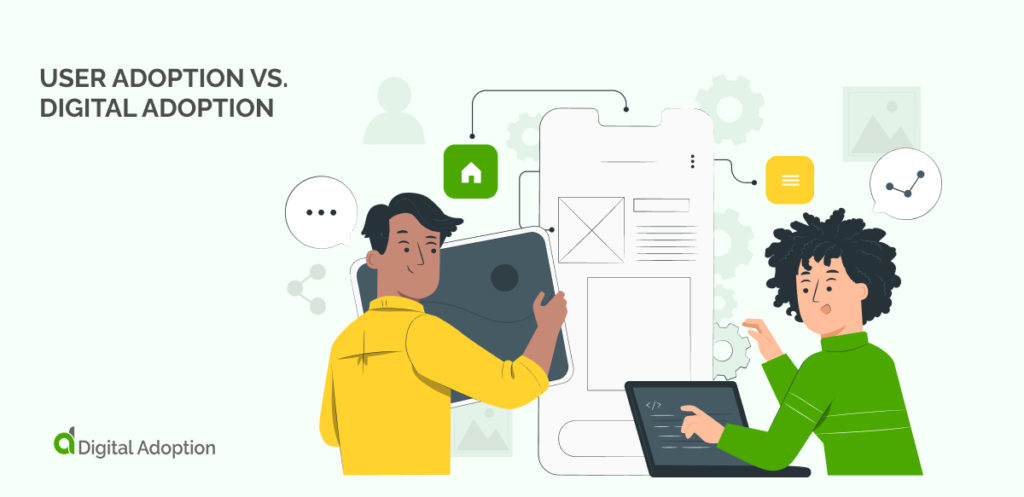
The heart of every digital adoption strategy is the user. User adoption is crucial within digital adoption because it is the digital adoption process. The short-term effectiveness of user adoption decides the long-term success of the digital adoption strategy.
Analyzing user adoption rates is critical to this process. If a company successfully onboards a customer or team member with an app or new software, they will use it forever. If they don’t have a positive experience, the opportunity is usually lost, along with the investment to create the app or software solutions.
Gartner provides a User Adoption Technology Readiness Index which companies can use to measure how ready customers or staff are to use new technologies.
Why are user adoption rates critical?
User adoption rates are the first place change leaders need to look when assessing the success of digital transformation initiatives. User adoption can show leaders how well users are adopting new technologies and why they must adjust the digital adoption strategy processes to ensure success.
Common user adoption strategies
To ensure success in digital adoption as part of digital transformation efforts, change leaders must utilize user adoption strategies, such as:-
- Offer a trial period to increase familiarity in a low-pressure environment.
- Identify activation criteria, such as ‘Send a message to a colleague on Slack.’
- Optimize user onboarding to make the process streamlined and accessible.
- Define why customers use the product so you know what idea you’re selling.
- Analyze usage rates for features and products as part of a continuous process.
- Promote buy-in for existing users as well as prospects.
Using these user adoption strategies allows users to adopt a new technology successfully. Part of the process of identifying activation criteria and optimizing the user engagement level through onboarding is more accessible using a digital adoption platform.
What Is A Digital Adoption Platform (DAP)?
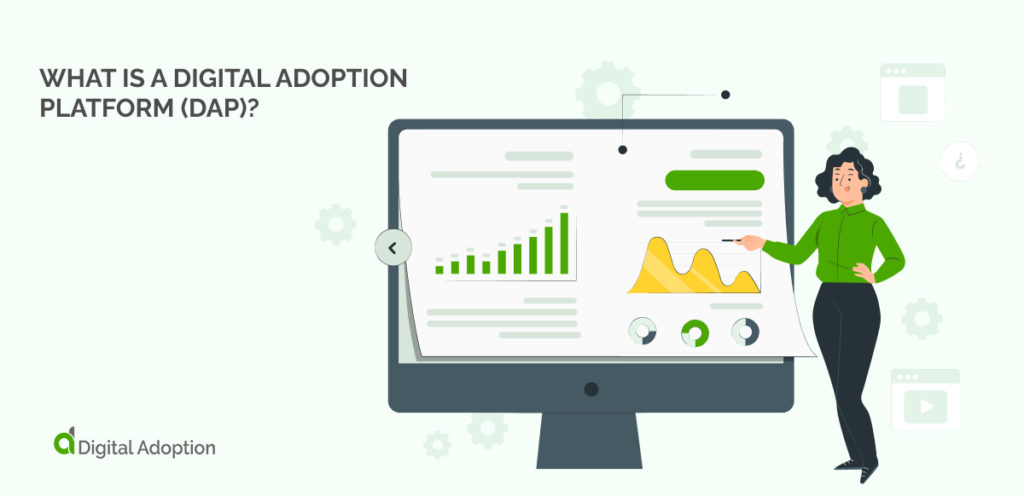
Large enterprises with complex digital adoption requirements and smaller SMEs require a Digital Adoption Platform (DAP) to drive digital adoption as part of their digital transformation strategy. These digital adoption tools show staff the best way to use new software on screen, such as recruitment software solutions or HR software, as well as many other applications.
The DAP administrator sets up the interface on screen by adding specific goals that the DAP uses to make recommendations for how the user engages with the DAP. DAPs also provide adoption insights so the administrator can see who is struggling with what feature or task at a glance and the ability to track user progress to identify problems, making employees’ jobs easier.
DAPs learn the user’s regular tasks, allowing them to auto-complete based on employee behaviors. This process heightensuser experience, improves user productivity, and boosts productivity and employee experience as they feel more positive about digital adoption and their learning changes and alters to fit individual learning styles.
What Is The Importance Of Digital Adoption Through Digital Transformation?
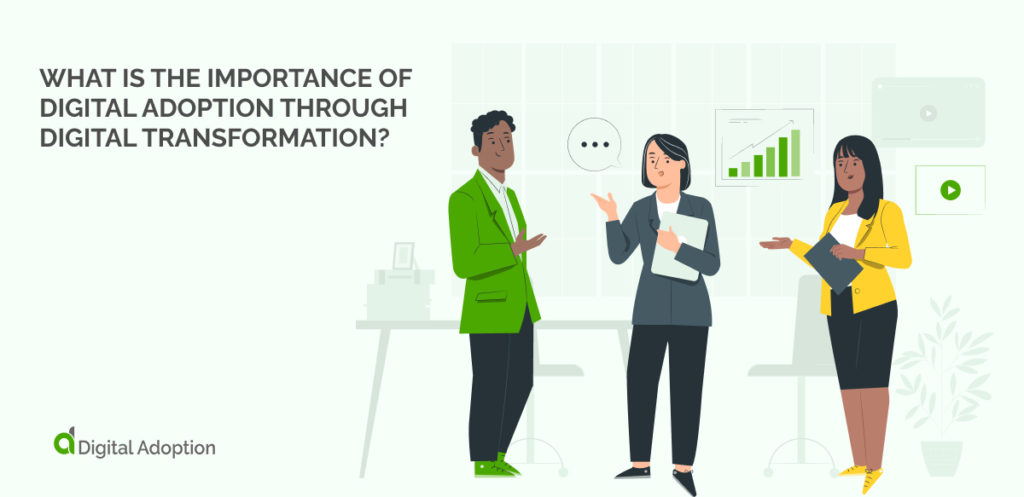
Digital adoption is an essential part of a company’s digital transformation efforts. Digital transformation initiatives are broader than digital adoption strategies. Digital transformation involves completely reevaluating the philosophy and approach toward new technology to benefit from digital changes.
The outcome is a set of agile and flexible attitudes toward a constantly changing market of digital disruption. This process includes the benefits of digital changes of integrating change via technology in every business process.
So why is digital adoption significant within digital transformation? Digital adoption is what needs to happen for successful digital transformations. Think of it as a driver in a car. The driver uses the vehicle and requires proper training to enable them to drive it, and the car increases the options for the driver socially and professionally. In the same way, digital adoption is the driver, and digital transformation is the car. So what are the benefits of digital adoption?
The Top 10 Benefits Of Digital Adoption

There are considerable benefits to every digital adoption solution, the first of which is that it encourages employee creativity.
1. Effective digital adoption allows employees to be more creative
Digital adoption is a means for employees to utilize technology to complete the repetitive tasks machines can automate. When this time is unlocked, employees have the resources to be more creative and innovative in their approach to new jobs, benefiting the organization.
2. Successful digital adoption leads to customer retention
Customers demand more and more digital innovation to make them feel they are getting the most up-to-date technology and value for money. This point makes digital adoption important as part of a successful digital transformation, as constant tech innovations mean retained customers.
When customers enjoy the new technology in a product or service, they become champions of the company, promoting it by word of mouth, expanding the customer base, and improving its reputation as a tech leader.
3. Digital adoption capabilities make employees feel valued
When employees engage with a digital adoption strategy, they feel they can do their role best. This action makes them feel valued as they are appreciated and given the best tools to fulfill their role. New employees feel valued when HR and senior management show that their new employer maintains a positive view toward constantly adopting new software applications and other digital tools during onboarding.
4. Engaging in digital adoption keeps stakeholders satisfied
Shareholders, customers, employees, and third parties must see progress and growth to feel like their investment is worth it. Constantly investing in new technologies is a good way of showing stakeholders that expansion and innovation are at the time of your company’s priorities to maintain resilience as a market leader.
5. Digital adoption boosts employee experience and engagement
Employees want to engage with services and products and align with companies that motivate them. Digital adoption creates a dynamic, user-centric environment where customers can do this.
6. Digital adoption programs increase communication channels
Try to imagine a workplace without Asana, Microsoft Teams, or Zoom. These technologies increase communication between CEOs, managers, and team members to boost business outcomes. It is difficult to do now that these technologies are part of our everyday experience.
Technology is critical in the age of hybrid and remote working when many team members do not communicate face-to-face with their managers. Digital adoption closes the communication gap between the office and home working environments.
7. Digital adoption promotes innovation
Innovation is essential to a company’s digital transformation efforts, making them competitive, sustainable, and resilient. Tech research for digital adoption allows companies to ensure they are achieving optimal business outcomes with available digital tools.
8. Every digital adoption solution increases efficiency
Digital adoption takes care of nearly all repetitive tasks, such as data entry and application tracking. Automating tasks allows staff to focus on the responsibilities that optimize and leverage their skills and experience, improving individual and organizational efficiency.
9. Competitive resilience gets a boost with digital adoption
Technology is at the heart of everything all companies do. Digital adoption is at the core of competitive resilience, and without constant innovation of digital tools, organizations will struggle to remain resilient and sustainable.
10. Better time-to-value for new clients
In the age of time management, efficiency and speed are everything. Digital adoption allows companies to ensure that products and services are designed for customers quickly and benefit them cost-effectively.
These are the top ten advantages of digital adoption, but what adoption strategies do we need for SaaS solutions?
How To Reduce Resistance To Digital Adoption
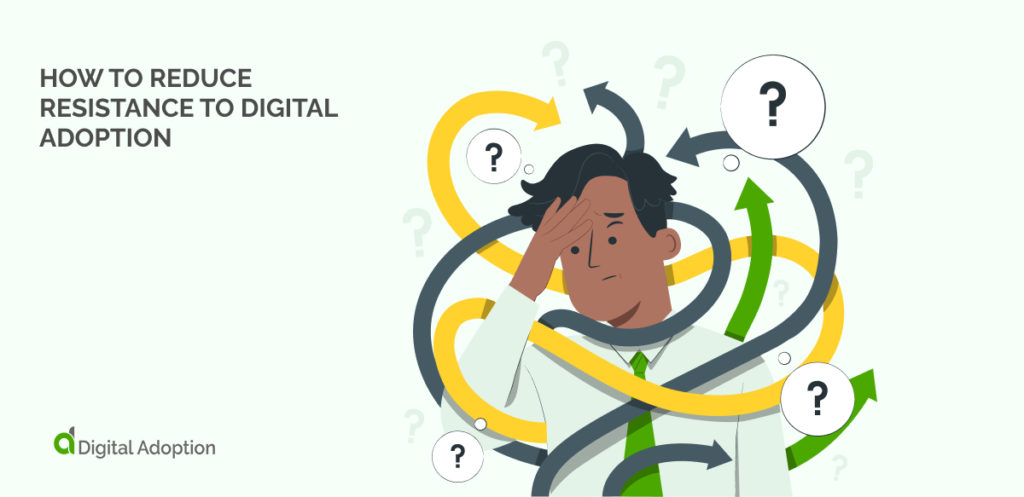
There are many ways to reduce the resistance to digital adoption. Firstly, digital change leaders must identify why team members resist change.
- Communicate with staff using 1:1 meetings and surveys to establish why they resist change and base strategies to reduce resistance around these reasons.
- Communicate the advantages of digital transformation to staff.
- Offer incentives to staff for championing digital transformations.
- Prioritize active learning through DAPs.
- Personalized training.
Digital adoption leaders use these methods to understand why the staff is resisting change and find a solution to support the team’s engagement with digital transformations. But once leaders have reduced the resistance to drive adoption, how does this process increase the product’s value?
How Does Digital Adoption Increase The Value Of The Product?

The value of the product brought by digital adoption splits into two categories: user product value and organizational product value.
User Value
The user product value involves how highly customers and staff value the product based on the following measures:-
- Usability – Usable products are easy to learn; remember how to continue using and understand the benefit of different features. Digital adoption platforms help users learn how to use new software more quickly, boosting user progress andemployee productivity.
- Meaning – Users need to feel that the experience of using the product is meaningful. If users do not understand the purpose of using a product in their role as customers or staff, they will not continue using it, and digital adoption will fail.
- Utility – Product utility involves how much use it is to the user and whether it is suited to their needs. The higher the utility, the higher the product value, and the greater the chances of successful digital adoption.
- The product experience – Product experience includes all the above three categories and other factors. Product experience depends on product consistency and brand image. The brand image also influences how a customer experiences a product based on how they perceive it and their knowledge of previous products from the same brand.
Organizational Value
Organizational value depends on factors more focused on the use of the software by hundreds of staff and the value the use of this software brings to the organization.
Performance and productivity of the software solution
Software must perform to its expectations to bring the most outstanding value to the organization, as this saves resources. The factors described above also affect this aspect of digital adoption, such as user proficiency and engagement with the product.
Level of software utilization
The organization must fully utilize a new software solution to get the most out of it, but this is not always the case. Tools like SaaS software for large enterprises contain several features. Still, staff must know how to use all of these features to ensure the highest level of digital adoption to give value to the organization.
Software digital ROI
ROI (Return On Investment) largely depends on the success of the digital adoption strategy based on all the factors mentioned above. ROI underpins the importance of all the above factors as they all contribute to ensuring that companies carry out digital adoption effectively to impact the bottom line positively.
There are many factors to ensuring the most product value through digital adoption. Measuring the success of a digital adoption strategy is essential to celebrating successes and reviewing outcomes to make adjustments and improvements to a product. Organizations measure the ROI of digital transformations using metrics and analytics.
How Do You Measure The Success Of A Digital Adoption Strategy?
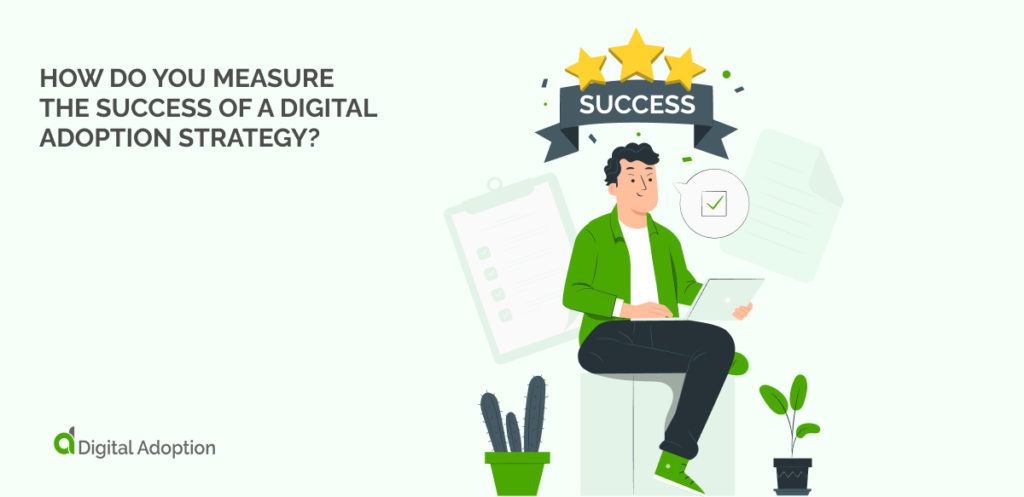
IT departments must measure the success of digital adoption via a thorough analysis of metrics that produce helpful analytics. The first step in this process involves the creation of a tracking plan to measure user success.
Develop a tracking plan
Organizations need to track user progress throughout the digital adoption strategy. Digital adoption leaders must liaise with IT departments and team leaders to establish the best ways to do this.
Select metrics
IT teams use metrics to measure the success of digital adoption within a digital transformation strategy. These metrics fall into four categories:-
Intention
What do you need to get out of the digital adoption strategy? What is the purpose of the new technology? What problem must the new software resolve?
Features
Do staff understand all the features of all the new tools? Do teams need extra training or more personalization to support them in understanding new mechanisms?
Satisfaction
Organizations use metrics such as ‘overall customer experience’ or ‘completion rate of intended task’ to measure user satisfaction.
Outcomes
The final metric measures the user’s ability to utilize the technology and if the organization and the individual feel they have gained value from the product. This point underpins that all key digital adoption strategies prioritize users, not the technology itself, as a gauge of success.
Capture baseline metrics
Once the organization has established the metrics, it must capture information to measure the success of digital adoption. There are several ways to implement this process, but they must all focus on the user.
Surveys and questionnaires collect user feedback on engagement and experience depending on the level of detail needed. Pulse surveys collect brief, regular feedback that can show subtle changes over time, and questionnaires provide contextual information taken at wider intervals.
Review Metrics and adjust strategy
Once the metrics have been implemented, and data is stored, IT departments convert it into analytics. CIOs and CTOs then decide how to communicate the analytics to team members in an accessible, meaningful way. Digital adoption leaders then use analytics to review the digital adoption strategies and adjust them as needed to realign outcomes to plans to boost user engagement and improve the chances of success.
Ten Key Strategies To Drive Digital Adoption
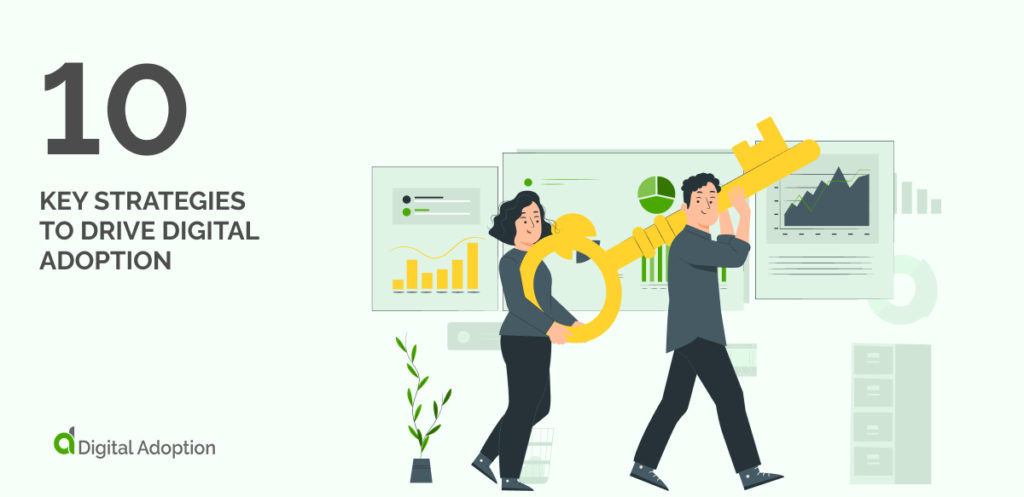
Key digital adoption strategies are essential to driving digital adoption toward successful outcomes. The first strategy falls within the planning stage and involves choosing a specific goal. A diverse team of leaders from different departments clearly defines the most important digital adoption strategies.
1. Pick a goal
Planning is the core of success for any digital adoption strategy. A diverse team of leaders from various departments must meet to align their needs to create a goal for the digital adoption strategy. This goal is the endpoint for the strategy and must benefit the organization using the new technologies within the digital transformation.
2. Decide what needs to be changed to meet the goal
Once the digital adoption project team has established a goal, they must define ways to achieve it. The team must write a list of actionable KPIs that team members can easily understand and execute. What training needs to be in place? Who will deliver the training? What resources will be required? Over what period will the digital transformations take place?
3. Utilize in-app guidance
In-app guidance is an essential part of digital adoption. It allows users to utilize software and learn as they work. Learning through doing is a much more effective way of absorbing information than having someone tell a staff member how to set up a workflow or automate applicant tracking on an HRM.
4. Eliminate employee resistance to change
Resistance to change is the biggest challenge of any change strategy. This point is particularly the case with digital transformation strategies, as staff often fear unknown technologies and that machines may replace them. The key to eliminating resistance is nurturing a culture of communication and understanding.
Change leaders must work with their colleagues by communicating the reasons for the digital adoption changes and listening to their concerns to understand the reasons for resistance. Once leaders collect this feedback, they can satisfy concerns and share information to create incentives for staff to use new technologies and assure them that new software will assist, not replace staff.
5. Provide contextual and personalized training to each user
Proper training sessions accept that everyone has a different learning style. Some employees are visual learners and learn best from graphs. Others are numerical or textual learners. Change leaders must utilize the software effectively to ensure that digital adoption meets every employee’s learning needs to ensure success.
6. Maximize engagement and adoption of pre-existing technologies
Leveraging existing technologies is essential to a successful digital adoption strategy. Training and knowledge for existing digital tools must be in place to create a baseline for the learning needs of each employee and ensure that new technologies are essential for organizational growth.
7. Provide learners with content in multiple formats
Change leaders must utilize digital solutions that meet traditional training demands as well as less conventional methods of training support. Change leaders must exist alongside new learning tools, such as employee peer coaching, improving collaboration, and widening communication channels between staff.
Digital adoption leaders must also remember that employees learn more effectively in their native language, so technology must meet this need to improve the employee experience of using new systems.
8. Implement changes
Leaders must ensure digital adoption provides a smooth transition to new tools for the entire organization. Structured planning should reduce the challenges of implementing the changes. However, it is essential to continue to track user progress at every stage of the digital adoption strategy to ensure that staff is invested in it, understand it, and is motivated to communicate concerns and improvements to leaders.
Success is assured when leaders offer ongoing support for staff processes maintained through employee training content as part of continuous digital transformation efforts. Digital adoption requires such investment in ongoing training because it is a huge learning curve for employees.
9. Communicate the successes of the digital adoption strategy
Digital adoption can be a challenging process for staff at every level, which makes communicating successes an important way to balance achievements with obstacles positively. Share successes little and often to maintain morale and incentivize digital adoption champions to create a positive perception of digital transformation in each team.
10. Review and adjust digital tools
Digital adoption is a long-term and complex process, as the focus is on people. Therefore, ongoing support is needed to collect feedback on improving training effectiveness, how the organization utilizes technology, and boosting productivity. A culture of encouraging input and converting it into actionable outcomes is essential to optimize a digital adoption strategy.
Successful Digital Adoption Involves A Focus On People
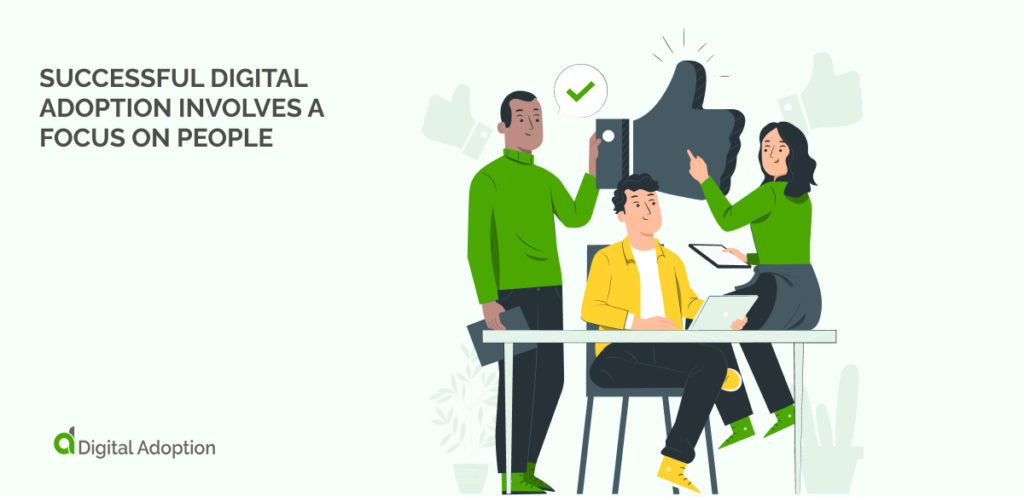
Digital adoption is a complex process as the challenges involve people rather than software or other digital tools. People are the heart of digital adoption, and the only way to ensure successful digital transformations is to focus on the staff at all levels. Change leaders must understand staff’s learning needs, baseline skills, and digital adoption concerns to launch a successful digital transformation. Change leaders must achieve high-impact digital adoption strategies using metrics to track digital adoption progress, then convert these data into analytics. Change leaders must present analytics to employees in a meaningful and appropriate way for their role. This way, all staff sees their feedback taken seriously and actioned. This method is the best way to ensure digital adoption successfully improves business outcomes and leads to expansion and increased revenue.



